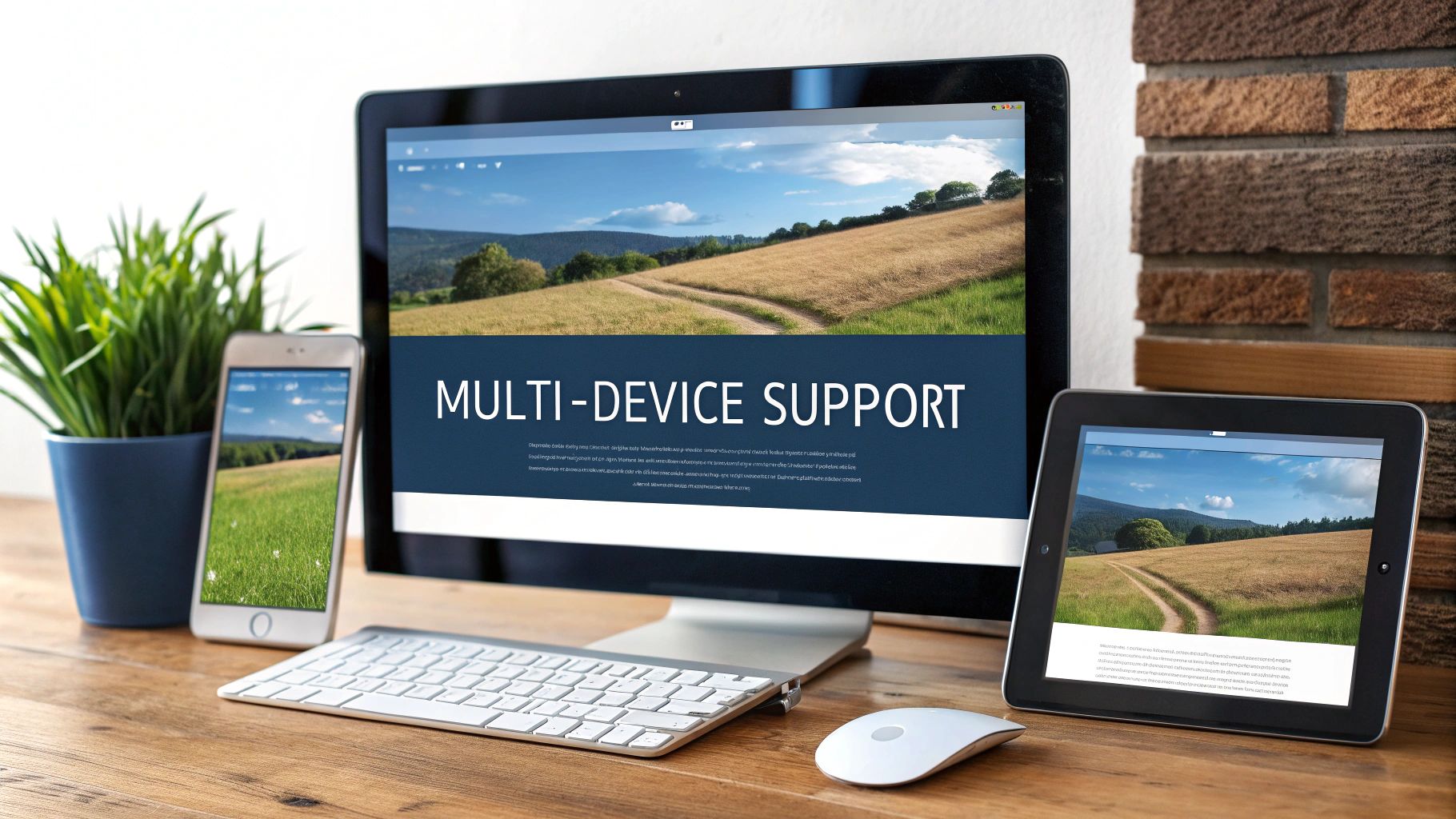10 Proven Responsive Web Design Techniques That Drive Exceptional Results
The Real Impact of Responsive Design on Business Growth
When your website doesn't work well on mobile devices, you're likely losing customers without even realizing it. Think about the last time you tried to use a website that wasn't mobile-friendly – frustrating, right? That's why responsive web design has become essential for any business that wants to grow online. Let's look at exactly how responsive design affects your bottom line and what you can do about it.
Why Responsive Design Is Crucial for Modern Businesses
The numbers tell a clear story – over 61% of all website traffic now comes from mobile devices. If your site isn't optimized for phones and tablets, you're potentially missing out on connecting with more than half your visitors. Picture this: a potential customer finds your website on their phone, but the text is tiny, buttons are hard to click, and images are cropped awkwardly. They'll likely leave and visit your competitor instead. This isn't just a theory – research shows that 73.1% of web designers point to poor mobile optimization as the main reason visitors abandon websites.
Good responsive design does more than just make your site work on phones – it creates a smooth, consistent experience no matter what device someone uses. When visitors can easily navigate your site and find what they need, they stay longer and are more likely to become customers. Studies back this up, showing that responsive websites get 11% more conversions and 15% more clicks from mobile users.
How Responsive Design Impacts Business Metrics
The benefits of responsive design directly affect your business results. Companies that optimize their sites for mobile devices typically see more sales – 62% report significant revenue increases after making the switch. Search engines like Google also prefer mobile-friendly websites, giving them better rankings in search results. This means more people find your site naturally through search, leading to more potential customers without spending extra on advertising.
Real-World Examples of Responsive Design Success
Many successful companies have seen big improvements after focusing on responsive design. Take Amazon for example – they use adaptive design (a type of responsive design) to ensure their massive product catalog works perfectly on any screen size. News sites like USA Today have also embraced responsive techniques, making their content easy to read whether you're on a phone during your commute or at your desk. These examples show how flexible layouts and proper sizing can create great experiences for all users.
Measuring and Optimizing Your Responsive Approach
To get the most from responsive design, you need to track how well it's working. Watch metrics like how many mobile visitors you get, how long they stay on your site, and how many take action (like making purchases or filling out contact forms). Use these insights to make smart updates to your design. For instance, if you notice mobile users leaving quickly on certain pages, you might need to simplify the layout or make buttons easier to tap. Regular testing and adjusting based on real user behavior helps ensure your site keeps performing well as devices and user habits change.
Mastering the Mobile-First Design Mindset
When creating websites today, starting with mobile design isn't optional – it's essential. This approach moves beyond simply scaling down desktop sites. Instead, it puts mobile users first and builds up from there. Getting this right leads to better experiences across all devices.
Understanding the Mobile User
Think about how you use your phone – you're often walking, taking transit, or multitasking. Mobile users need quick access to information on smaller screens through touch. This means designers must focus on speed, simplicity and touch-friendly elements. Take buttons, for example – they need enough space around them so users don't accidentally tap the wrong thing. Content should be brief and scannable, since people tend to skim on mobile.
The Benefits of Mobile-First
Starting with mobile screens forces you to focus on what really matters. You have to decide what content and features are truly essential when space is limited. As you expand to larger screens, you can thoughtfully add more elements and functionality. This "start small, build up" method naturally creates faster-loading sites, since you begin with a minimal foundation. The numbers back this up – faster sites consistently see more engagement and sales compared to slower ones.
Implementing Mobile-First in Practice
Here's how to put mobile-first design into action:
- Content Prioritization: Figure out the key information users need on mobile and remove everything else. Focus on delivering value quickly.
- Streamlined Navigation: Create simple menus that work well with touch. Use clear visual cues to show where users can tap.
- Flexible Layouts: Use CSS Grid and Flexbox to build layouts that adjust smoothly across screen sizes.
- Performance Optimization: Compress images, write efficient code, and use caching to ensure fast loading, especially on mobile networks.
Real-World Examples of Mobile-First Success
Let's look at how real companies have succeeded with mobile-first design. News sites often show headlines and short summaries first, letting readers tap to see full articles if interested. Online stores simplify checkout on mobile by reducing form fields and breaking the process into clear steps. These changes make a real difference – companies regularly see more engagement and sales after optimizing for mobile users. Understanding how people actually use mobile devices helps create better experiences that work well on any screen size.
Advanced CSS3 Media Queries That Actually Work
Getting CSS3 media queries right is essential for making websites that work well across all devices. These queries are the key mechanism that lets you adjust your site's layout and styling based on screen size and other device characteristics. With proper implementation, your site can provide an excellent experience whether someone visits from their phone, tablet, or desktop computer. Let's explore some practical approaches and common pitfalls to avoid.
Beyond Simple Breakpoints: Thinking in Ranges
Rather than setting fixed breakpoints for specific devices, it's better to think in terms of ranges that accommodate different screen sizes. For example, instead of targeting exactly 768px for tablets, you could set a range between 768px and 1024px. This approach works better since tablets come in many sizes. It also means you won't need to keep updating your code as new devices hit the market.
Targeting Specific Features with Media Queries
Media queries can do much more than just respond to screen sizes. They let you fine-tune the experience based on how people use their devices. For example, you can adjust your design based on whether someone prefers light or dark mode, or make text more readable based on their accessibility settings.
Here are some useful media features you can work with:
prefers-color-scheme: Adjusts to the user's light or dark mode preferenceprefers-reduced-motion: Makes animations gentler for users who are sensitive to motionorientation: Changes layout based on portrait or landscape device positionaspect-ratio: Helps maintain proper sizing for images and videos across different screen shapes
Combining Media Queries for Complex Scenarios
Sometimes you need to use multiple conditions together to handle specific situations. This gives you precise control over your styling and ensures consistency across different devices and settings. For instance, you might want certain styles to apply only when someone uses a tablet in landscape mode.
Here's a practical example:
/* Styles for tablets in landscape mode */
@media (min-width: 768px) and (max-width: 1024px) and (orientation: landscape) {
body {
font-size: 1.2em; /* Increase font size slightly */
grid-template-columns: repeat(3, 1fr); /* Adjust grid layout */
}
}
This code targets devices with screens between 768px and 1024px that are being held horizontally. By combining conditions like this, your site can adapt more intelligently to how people actually use it. The result is better usability and a smoother experience for your visitors, regardless of their device or preferences.
Building Flexible Layouts That Scale
Making websites look good on every screen size is about more than just adjusting dimensions. The key is building flexible layouts that adapt smoothly across devices while keeping content easy to navigate and read. Two essential tools make this possible – CSS Grid and Flexbox. Let's explore how to use them effectively.
Harnessing the Power of CSS Grid
CSS Grid brings a structured approach to web layouts, similar to how city streets form organized blocks. It lets you create precise rows and columns to arrange content exactly how you want it. For example, you can set up a 12-column grid on desktop that smoothly shifts to 6 columns on tablets and a single column on phones. This helps maintain visual hierarchy across screen sizes so your most important content always stands out.
Embracing the Flexibility of Flexbox
While Grid handles the overall page structure, Flexbox excels at organizing elements within containers – like arranging books on a shelf. You can align items left, right, center, or space them evenly with simple controls. This makes it perfect for components like navigation menus, image galleries, or content cards. The flexibility of Flexbox ensures these elements stay neatly arranged even as screen sizes change.
Combining Grid and Flexbox for Optimal Results
The real magic happens when you use Grid and Flexbox together. Grid provides the main structure while Flexbox handles the details within sections. Take a typical three-column desktop layout – Grid creates the columns while Flexbox aligns the text, images and other elements within each one. This combination gives you both precision and flexibility, so your layouts work beautifully at any size.
Real-World Applications of Flexible Layouts
You can see these techniques in action on many popular sites. Online stores often use Grid to create responsive product listings while using Flexbox to arrange product details within each card. News sites similarly use Grid for their homepage structure, letting article previews reflow naturally on different devices. With over 61% of web traffic now coming from mobile, this adaptable approach is key for reaching users effectively. It also helps with search rankings since Google prioritizes mobile-friendly sites. The result? Better engagement and a smoother experience for everyone visiting your site.
Smart Media Optimization Strategies
Web performance is crucial in modern website design. Managing images and other media effectively across screen sizes isn't just a nice-to-have – it directly impacts how users experience your site. When media files aren't properly optimized, they can slow down page loads significantly, especially on mobile devices. Given that images typically make up over 20% of a website's total size, smart media optimization is essential for delivering fast, engaging experiences.
Responsive Images With srcset and <picture>
The srcset attribute and <picture> element are powerful tools for serving the right image sizes to different devices. Rather than sending the same large image file to every user, these features let you provide multiple versions optimized for different screens. A mobile user doesn't need to download a 4K desktop image when a smaller file would work perfectly.
Here's how srcset works: You provide a list of image files and their widths, and the browser automatically selects the most appropriate version based on the user's screen. For example, you might offer a 2000px wide image for large monitors and an 800px version for phones.
The <picture> element takes this flexibility even further by enabling art direction – showing completely different image crops or aspect ratios based on screen size. This is especially useful when a simple resize won't deliver the best visual experience. You could display a wide landscape shot on desktop but switch to a tighter vertical crop on mobile where it makes more sense.
Optimizing Video and Interactive Content
Video content creates unique optimization challenges. Like images, serving different video formats and quality levels helps balance quality and performance. Modern formats like WebM and MP4 allow browsers to choose the optimal version based on connection speed and device capabilities.
Lazy loading is another key technique for video and interactive elements. Instead of loading everything at once, content loads only when users scroll near it. For long pages with multiple videos, this prevents unnecessary downloads and dramatically speeds up initial page loads. The result is a smoother, more responsive experience – users get content quickly without waiting for videos they may never watch to finish loading.
Real-World Optimization Strategies for Success
Many successful websites demonstrate these optimization principles in action. News sites commonly serve smaller preview images in article listings, loading full-resolution versions only when users click through. E-commerce platforms use <picture> elements to adapt product images for different devices, maintaining visual appeal across screen sizes. With 72% of users preferring mobile-friendly sites, these optimizations directly impact engagement and conversions.
Smart media handling isn't just about technical best practices – it's about delivering the best possible experience to every user. When implemented thoughtfully, responsive image and video techniques create faster, more engaging websites that keep visitors coming back. The keys are choosing the right optimization approaches for your content and testing thoroughly across devices to ensure consistent quality.
Testing and Performance Excellence
Getting your layouts and media working well is important, but the true test comes from real-world performance. Testing rigorously and optimizing speed are essential steps to deliver a great responsive website. After all, what good is a beautiful design if it loads slowly or breaks on certain devices? Let's look at the key aspects of testing and optimization.
Essential Testing Tools and Methodologies
You need to test extensively across different devices and browsers – there's no way around it. Thankfully, several tools make this process much easier. Start with your browser's built-in developer tools to check different screen sizes and network conditions. For more thorough testing, tools like Selenium help automate cross-browser checks. Services like BrowserStack let you test on real physical devices.
For instance, when you create a complex layout with CSS Grid, these tools help catch rendering issues before users encounter them. Finding and fixing problems early through testing is much better than dealing with frustrated user complaints later.
Performance Metrics That Actually Matter
While there are many ways to measure performance, some metrics impact users more directly than others. Focus on what users actually experience. Google PageSpeed Insights helps track load times – critical since 32% of visitors leave if a page takes over 3 seconds to load. First Contentful Paint shows when users first see content, while Time to Interactive measures when they can start using your site.
This means you should compress images, minimize code, and set up good caching. Small changes like optimizing image file sizes can make a big difference in load times, especially on mobile networks.
Strategies for Maintaining Optimal Loading Speeds
Keeping your site fast requires ongoing attention. Monitor performance as you add features and content, making adjustments when needed. Use a Content Delivery Network (CDN) to serve files from locations closer to your users. Load images and videos only when needed through lazy loading. Keep your code clean and reduce server requests to improve how quickly pages respond.
Check regularly for things that slow your site down. Large images or inefficient code can really hurt load times. By staying on top of performance and making improvements, you keep users happy and represent your brand well. Since 72% of people prefer mobile-friendly sites, this attention to responsive design is worth the effort.
Testing Checklist for Responsive Web Design
| Feature | Test Cases | Tools |
|---|---|---|
| Layout | Cross-browser compatibility, screen size adjustments, orientation changes | Browser developer tools, BrowserStack, Selenium |
| Navigation | Touchscreen functionality, menu responsiveness, link accessibility | Device testing, automated testing frameworks |
| Images and Media | Load times, responsiveness, proper scaling | PageSpeed Insights, WebPageTest |
| Forms and Interactive Elements | Functionality across devices, input field responsiveness | Device testing, user testing |
| Performance | Page load speed, Time to Interactive, overall responsiveness | PageSpeed Insights, Lighthouse, GTmetrix |
Want to improve your development workflow and optimize site performance? DebugBar provides helpful tools and insights for creating better user experiences.




Comments
Leave a comment